#cordoba Córdoba
Text

Mosque-Cathedral of Córdoba, Córdoba | Spain | 2023
#travel#travel blog#wanderlust#europe#travel europe#travel photography#Córdoba#cordoba#cordoba mosque#cordoba mosque-cathedral#architecture#visit spain#travel spain#travel cordoba#visit cordoba
142 notes
·
View notes
Text


The mihrab.
Mezquita-Catedral de Córdoba, Spain
Jan. 1, 2022
Explore:
#Mezquita-Catedral de Córdoba#mihrab#cathedral#spain#españa#cordoba#travel#architecture#original photography#photographers on tumblr#photography#lensblr#historical architecture#mosque#andalusia#moorish#wanderingjana
18 notes
·
View notes
Text

Photographer - shy-girl04 : Mezquita de Córdoba, Cordoba, Spain 2014
14 notes
·
View notes
Text

Alfonso XI, El Justiciero (The Avenger) - Siege of Priego 1341
by Rocío Espín Piñar
#alfonso xi#king#castile#léon#siege#art#reconquista#spain#iberia#spanish#history#europe#european#castle#priego de córdoba#castillo de priego de cordoba#medieval#middle ages#knights#andalucía#andalucia#fortress#rocío espín piñar#illustration#reconquest#crusades#crusade#crusaders#crusader#castilian
93 notes
·
View notes
Text
9th part of the bookscans of Al Andalus. Historical Figures, here's the previous part
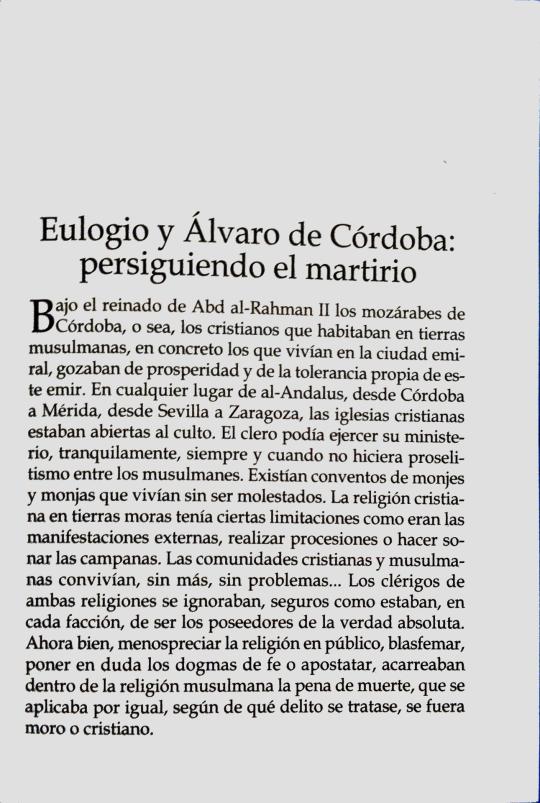
Eulogio and Álvaro de Córdoba:
pursuing martyrdom
Under the reign of Abd al-Rahman II the Mozarabs of Córdoba, that is, the
Christians who lived in Muslim lands, specifically those who lived in the emiral city, enjoyed prosperity and the tolerance typical of this emir. Anywhere in al-Andalus, from Córdoba to Mérida, from Seville to Zaragoza, the Christian churches were open for worship. The clergy could exercise his ministry, quietly, as long as he did not proselytize among the Muslims. There were convents of monks and nuns who lived without being bothered The Christian religion in Moorish lands had certain limitations such as the external manifestations, carrying out processions or ringing the bells. The Christian and Muslim communities lived together, without further ado, without problems... The clerics of both religions ignored each other, sure as were, in each faction, to be the possessors of the absolute truth. Now
well, belittling religion in public, blaspheming, questioning dogmas
of faith or apostatizing, carried within the Muslim religion the penalty of death, which was applied equally, depending on what crime it was, whether if the person was Moor or Christian.
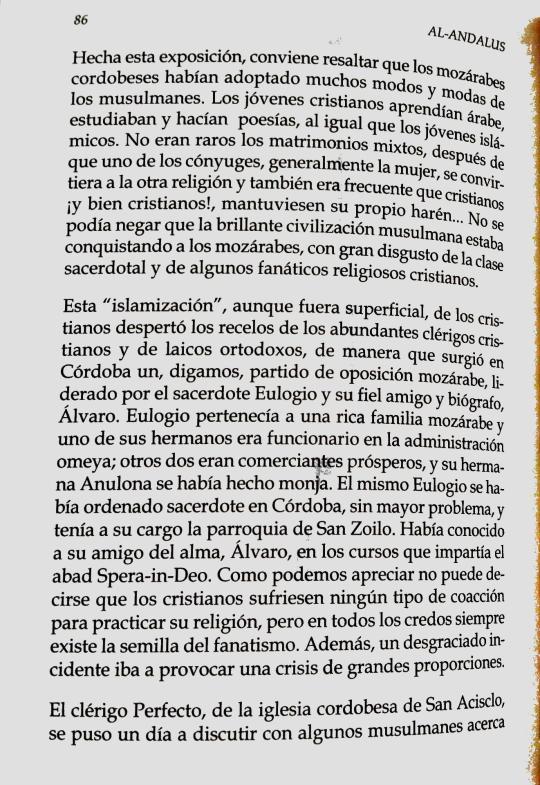
Having made this exposition, it is worth highlighting that the Mozarabs of Cordoba
had adopted many ways and fashions of the Muslims. Young Christians learned Arabic, studied and wrote poetry, just like the Islamic youth. Mixed marriages were not uncommon, after one of the spouses, usually the woman, converts to the other religion and it was also common for Christians, and very Christians, to maintain their own harem... It could not be denied that the brilliant Muslim civilization
was conquering the Mozarabs, to the great displeasure of the priesthood class and some Christian religious fanatics.
This "Islamization", even if it was superficial, of the Christians aroused the
suspicions of the abundant Christian clerics and Orthodox laymen, of way that a, let's say, Mozarabic opposition party emerged in Córdoba, led by the priest Eulogio and his faithful friend and biographer, Álvaro. Eulogio belonged to a rich Mozarabic family and one of his brothers was official in the Umayyad administration; two others were merchants
prosperous, and his sister Anulona had become a nun. Eulogius himself
had been ordained a priest in Córdoba, without much problem, and had his
charge of the parish of San Zoilo. He had met his soul friend, Alvaro in the courses taught by Abbot Spera-in-Deo. As we can see, It can be not said that Christians suffered type of coercion to practice their religion, but in all faiths there is always the seed of fanaticism. Furthermore, an unfortunate incident was going to cause a crisis of great proportions.
The clergyman Perfecto, from the Cordoban church of San Acisclo, one day began to argue with some Muslims about
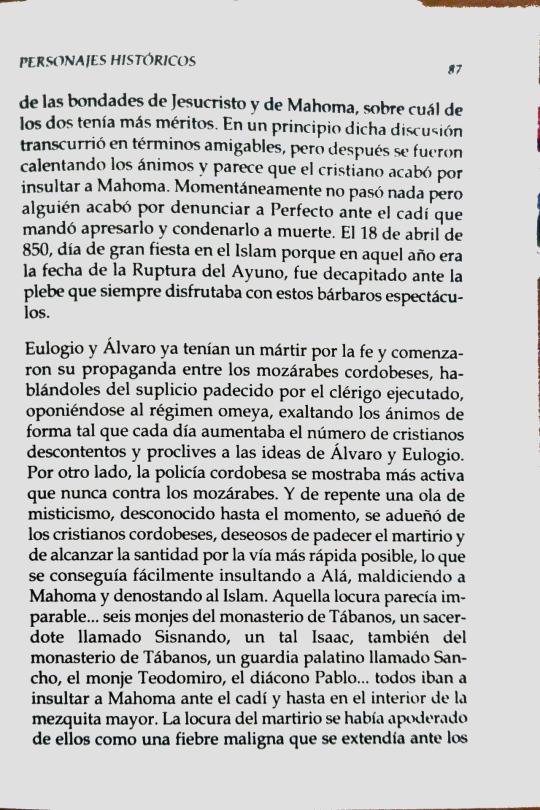
of the goodness of Jesus Christ and Muhammad, about which of the two had more merits. At first the discussion was on friendly terms, but later tempers were heating up and it seems that the Christian ended up insulting Muhammad. Momentarily nothing happened but someone ended up reporting Perfecto to the the cadi who ordered him to be arrested and sentenced to death. On April 18, 850, day of great holiday in Islam because that year was the date of the Breaking of the Fast, it was beheaded before the plebs who always enjoyed these barbaric spectacles.
Eulogio and Álvaro already had a martyr for the faith and began their propaganda among the Mozarabs of Cordoba, telling them about the torture suffered by the clergyman executed, opposing the Umayyad regime, raising spirits in such a way that every day the number of discontented Christians inclined to the ideas of Álvaro and Eulogio. On the other hand, the Córdoba police were more active than never against the Mozarabs. And suddenly a wave of mysticism, unknown until moment, took over the Christians of Cordoba, eager to suffer the martyrdom and achieving sainthood in the quickest way possible, which was achieved
easily insulting Allah, cursing Muhammad and reviling Islam. That madness seemed unstoppable...six monks from the Tábanos monastery, a priest named Sisnando, a certain Isaac, also from the Tábanos monastery, a guard palatine named Sancho, the monk Teodomiro, the deacon Pablo... they all went to insulting Muhammad before the qadi and even inside the main mosque. The madness
of martyrdom had taken hold of them like a malignant fever that spread before the
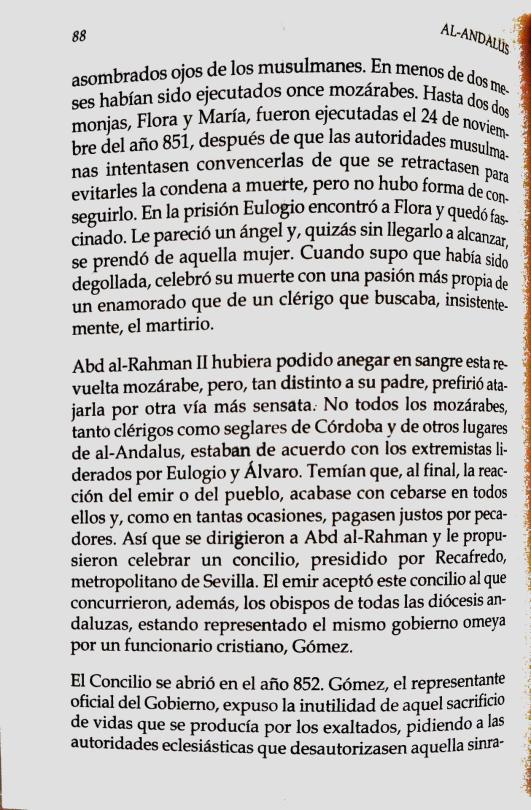
amazed eyes of the Muslims. In less than two months they had been eleven Mozarabs executed. Even two nuns, Flora and María, were executed on November 24, 851, after the Muslim authorities tried to convince them to recant to avoid the death sentence, but there was no way to achieve it. In prison Eulogio found Flora and was fascinated. It seemed like a
angel and, perhaps without reaching him, he fell in love with that woman. When
knew that she had been beheaded, he celebrated her death with a greater passion typical of a lover than of a clergyman who was insistently seeking,
the martyrdom.
Abd al-Rahman II could have drowned this revolt in Mozarabic blood, but, so different from his father, he preferred to tackle it by another sensiblebway. Not all the Mozarabs, both clerics and laymen of Córdoba and from other places in al-Andalus, agreed with the extremists
led by Eulogio and Álvaro. They feared that, in the end, the emir's reaction
or the town, ended up attacking all of them and, as in so many sometimes, the righteous paid for sinners. So they approached Abd al-Rahman and proposed holding a council, presided over by
Recafredo, metropolitan of Seville. The emir accepted this council to which, in addition, the bishops of all the Andalusian dioceses attended, the Umayyad government itself being represented by a Christian official, Gómez.
The Council opened in the year 852. Gómez, the official representative of the
Government, exposed the futility of that sacrifice of lives that occurred
by the exalted, asking the ecclesiastical authorities to disavow that non-
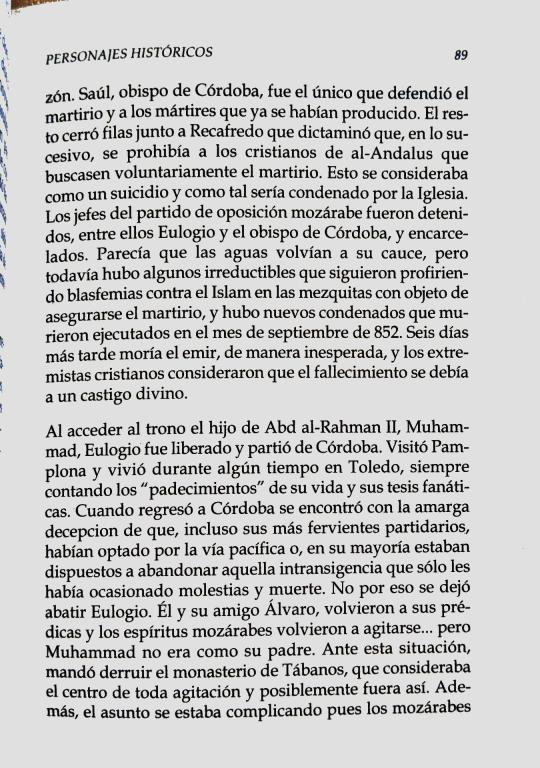
sense. Saúl, bishop of Córdoba, was the only one who defended martyrdom and the martyrs that had already occurred. The rest closed ranks with Recafredo who
ruled that, from now on, the Christians of al-Andalus were prohibited from
voluntarily seek martyrdom. This was considered suicide and
as such he would be condemned by the Church. The leaders of the Mozarabic opposition party were arrested, among them Eulogio and the bishop of Córdoba, and imprisoned. It seemed that the waters were returning to their channel, but there was still some irreducibles who continued uttering blasphemies against Islam in the
mosques in order to ensure martyrdom, and there were new convicts who were executed in the month of September 852. Six days later the emir died, unexpectedly, and the Christian extremists considered that the death was due to divine punishment.
When Abd al-Rahman II's son, Muhammad, acceded to the throne, Eulogius was released and left Córdoba. He visited Pamplona and lived for some time in Toledo, always recounting the "sufferings" of his life and his fanatical theses. When he returned to Córdoba he was met with the bitter disappointment that, even his most fervent supporters had opted for the peaceful route or, for the most part, were willing to abandon that intransigence that had only caused inconvenience and death. That's not why Eulogio let himself be discouraged. Him and his friend Álvaro, they returned to their preachings and the Mozarabic spirits stirred again... but Muhammad was not like his father. Faced with this situation, he ordered the demolition of the Tábanos monastery, which he considered the center of all unrest and possibly it was like that. Furthermore, the matter was becoming complicated because the Toledoan
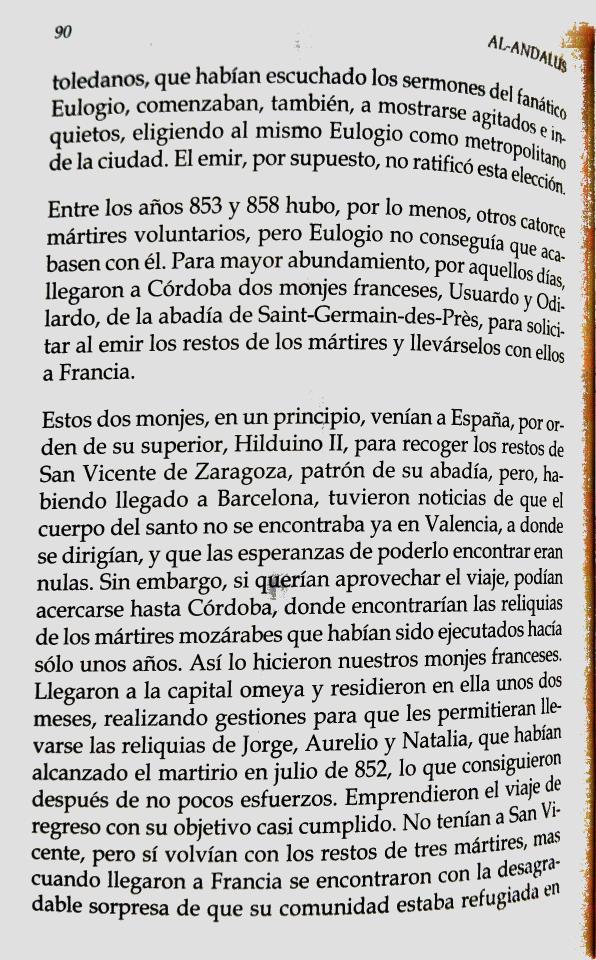
Mozarabs who had listened to the sermons of the fanatic Eulogio, were also beginning to appear agitated and restless, choosing Eulogio as metropolitan of the city. The emir, of course, did not ratified this election.
Between the years 853 and 858 there were at least fourteen other martyrs volunteers, but Eulogio couldn't get them to finish him off. For more abundance, in those days, two French monks arrived in Córdoba,
Usuard and Odilard, from the abbey of Saint-Germain-des-Près, to request the remains of the martyrs from the emir and take them with them to France.
These two monks, at first, came to Spain, by order of their superior, Hildouin II, to collect the remains of S. Vicente de Zaragoza, patron of his abbey, but, having arrived in Barcelona, they had news
that the saint's body was no longer in Valencia, where it was led, and that the hopes of being able to find him were zero.
However, if they wanted to take advantage of the trip, they could go to Córdoba,
where they found the relics of the Mozarabic martyrs who had been
executed only a few years ago. This is what our French monks did. They arrived in the Umayyad capital and lived there for about two months, taking steps to allow them to take the relics of Jorge, Aurelio and Natalia, who had achieved martyrdom in July 852, what they achieved after quite a bit of effort. They started the journey
back with his goal almost accomplished. They did not have S. Vicente, but they did returned with the remains of three martyrs, but when they arrived in France they found themselves with the unpleasant surprise that their community was
refugee in
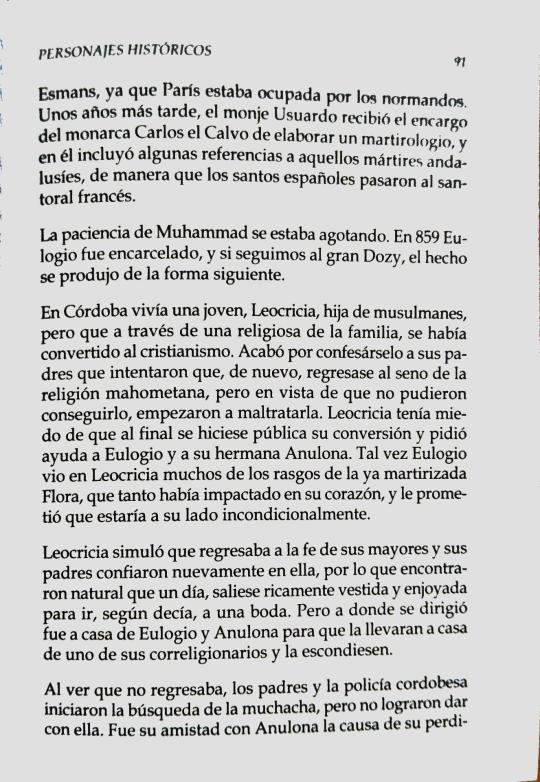
Esmans, since Paris was occupied by the Normans. A few years later, the monk Usuard received the commission from the monarch Charles the Bald to prepare a
martyrology, and in it he included some references to those Andalusian martyrs,
so that the Spanish saints passed to the French saints.
Muhammad's patience was wearing thin. In 859 Eulogio was imprisoned, and if we follow the great Dozy, the event occurred in the following way.
In Córdoba there lived a young woman, Leocricia, daughter of Muslims, but through a nun in the family, had converted to Christianity. She ended up confessing it to his parents who tried to get her to return to the bosom of the Mohammedan religion, but since they could not obtain it,
they began to mistreat her. Leocricia was afraid that in the end her conversion would become public and asked Eulogio and his sister Anulona for help. Maybe Eulogio saw
in Leocricia many of the traits of the already martyred Flora, who had so much
shocked in his heart, and he promised that he would be by his side unconditionally.
Leocricia pretended to return to the faith of her elders and her parents trusted
again in it, so they found it natural that one day, it would come out richly dressed and jeweled to go, as she said, to a wedding. But where she went to Eulogio and Anulona's house so they could take her to the house of one of her coreligionists and hid her.
Seeing that she did not return, the parents and the Córdoba police began the search
of the girl, but they could not find her. It was his friendship with Anulona that
cause of her perdi-
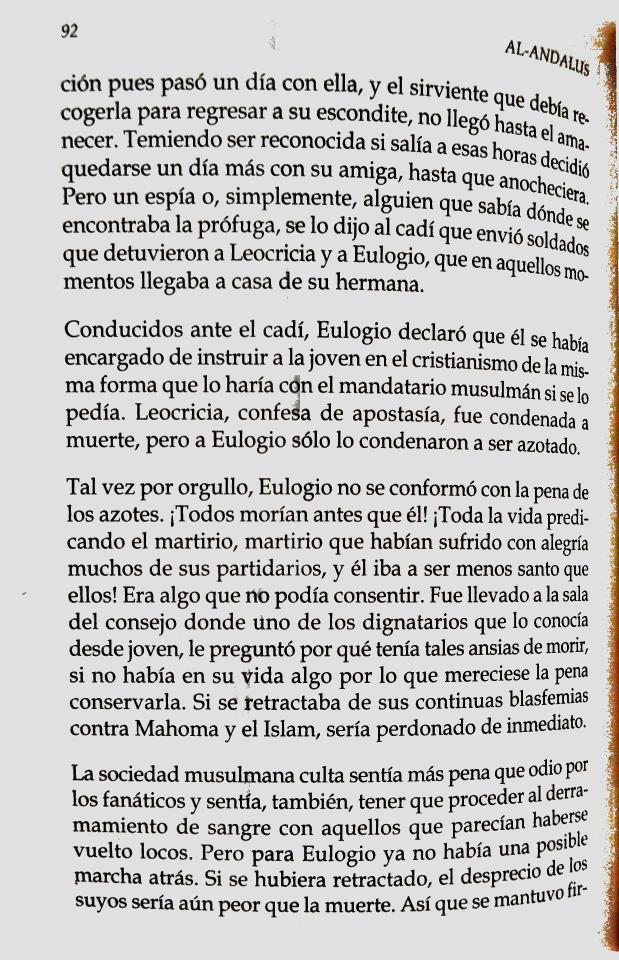
tion because she spent a day with her, and the servant who was to pick her up to
return to her hiding place, she did not arrive until dawn. Fearing to be recognized if she went out at that time, she decided to stay one more day with her friend, until nightfall. But a spy or simply someone who knew where the fugitive was, told the cadi who sent soldiers to arrest Leocricia and Eulogio, who at that time was reaching
his sister's house.
Brought before the cadi, Eulogio declared that he had taken care of instruct the young woman in Christianity in the same way as he would with the Muslim leader if he asked. Leocricia, confessed of apostasy,
was sentenced to death, but Eulogio was only sentenced to be whipped.
Perhaps out of pride, Eulogio did not settle for the punishment of whipping. Everyone died before him! All his life preaching martyrdom, martyrdom that many of his supporters had suffered with joy, and he
I was going to be less holy than them! It was something he couldn't consent. He was taken to the council room where one of the dignitaries who knew him since he was young, he asked him why he had such a desire to die, if there was no something in his life worth keeping. If he retracted
of his continued blasphemies against Muhammad and Islam, he would be forgiven immediately.
The cultured Muslim society felt more pity than hatred for the fanatics and they also felt that they had to proceed to shed blood with those who seemed to have gone crazy. But for Eulogio there was no longer a possible retreat. If he had retracted, the contempt of his people would be even worse than death. So he stood firm
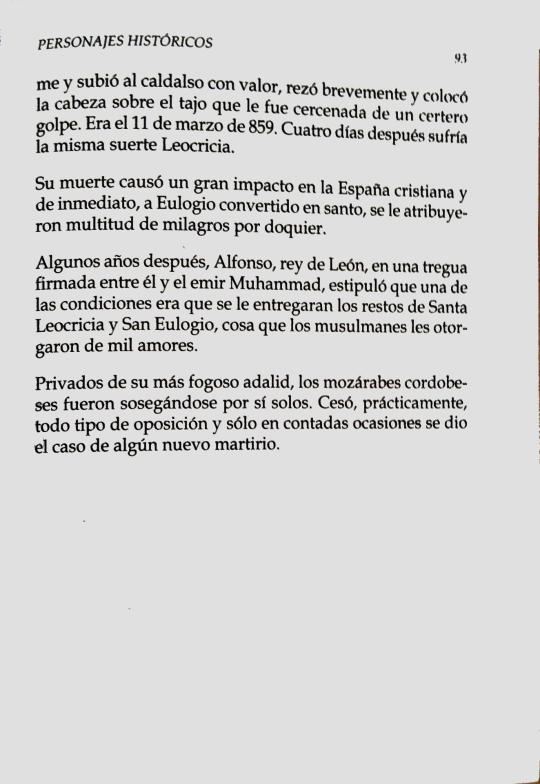
and he bravely climbed into the scaffold, prayed briefly and placed his head on the
slash that was severed with a well-aimed blow. It was March 11, 859. Four days later Leocricia suffered the same fate.
His death caused a great impact in Christian Spain and immediately,
Eulogio became a saint, a multitude of miracles were attributed to him
everywhere.
Some years later, Alfonso, king of León, in a truce signed between him and the emir Muhammad, stipulated that one of the conditions was that the remains of S. Leocricia and S. Eulogio would be handed over, something that Muslims gave them a thousand loves.
Deprived of their most fiery champion, the Mozarabs of Córdoba were calming down on their own. Practically all types of opposition ceased and only on rare occasions there was the case of a new martyrdom.
#al andalus. historical figures#al andalus. personajes históricos#al andalus#book scans#al andalus history#bookblr#historyblr#spanish history#emirate of cordoba#eulogio de córdoba#álvaro de córdoba#emirato de córdoba
15 notes
·
View notes
Text

12 notes
·
View notes
Text
Urban population: 2,106,734
Time zone: UTC -3
Note that this poll refers to the Córdoba in Argentina, not the one in Spain.
9 notes
·
View notes
Text

https://infomarruecos.ma/carta-a-los-lectores-homenaje-al-gral-don-jose-de-san-martin-su-fallecimiento-dr-jorge-bernabe-lobo-aragon/
#argentina#españa#córdoba#argentinahttps#escritoreshttps#mundohttps#cordoba#39;s profile: https://www.linked#tumblr milestone#amor
2 notes
·
View notes
Text

Yany Prado by © Edward Córdoba
2 notes
·
View notes
Photo



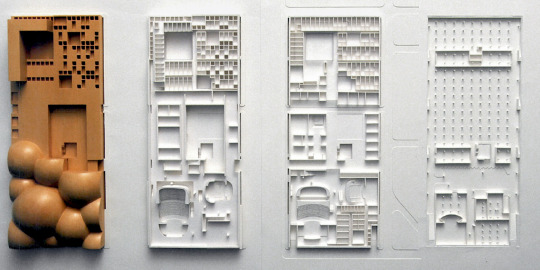


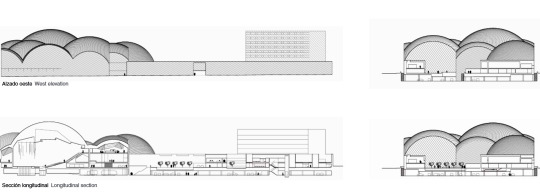

“Córdoba Congress Centre”, Cordoba, Spain [Competition, 2001] _ Architect: Rafael Moneo.
“The project proposed brings the program’s three very different elements – Congress Centre, Hotel, and Visitor Centre – together in one piece, as they are all included in one enclosure defined by a common perimeter. The intense occupation of the ground blurs the boundaries, and the enclosed precinct makes the three buildings be understood as one, which does not prevent them from functioning independently. On the other hand, the full occupation of the site guarantees that there will be no leftover spaces, so the Córdoba Congress Centre will own its ground without imposing upon its modest neighbours.
The Mosque has clearly influenced how the plot is used in the project, but it is also necessary to acknowledge how the profile of its roofs and of its tower has also been a determining factor in defining the face of the new piece. The building has been designed as a continuation of segmented domes that are able to trace a quasi-fortuitous silhouette with the same randomness as the roofs of Córdoba. The image of the Córdoba Congress Centre is thus entrusted to the constellation of segmented domes, a firm and clear image but not domineering. The domes are finished in glazed tile and their glow will help reinforce the corporeality of the spheres. Besides, the double roof will help establish a more efficient insulation system, which is particularly important in a place like Córdoba, with such an extreme climate.”
https://arquitecturaviva.com/works/centro-de-congresos-de-cordoba-rafael-moneo
https://arquitecturaviva.com/publicaciones/av-monografias/rafael-moneo
#Córdoba Congress Centre#Cordoba#Spain#Competition#2001#Rafael Moneo#José Rafael Moneo Vallés#Pritzker Prize#1996#RIBA Royal Gold Medal#2003#La Biennale's Golden Lion#2021
22 notes
·
View notes
Photo

SEAT Córdoba Vario advert. Spain, 1997
13 notes
·
View notes
Photo

Se trata de uno de los Conservatorios más antiguos de España, creado en 1902 por la Diputación Provincial de Córdoba a partir de la sección de Música de la Escuela Provincial de Bellas Artes. Su primer director fue el músico Cipriano Martínez Rücker. En 1918 terminó la carrera de piano Dolores de Santiago Carrión; también obtuvo medalla de oro por unanimidad en el concurso del tercer año de canto. Su profesor era José Rodríguez Cisneros, director del Conservatorio. En 1922 el Estado da validez oficial a las enseñanzas impartidas en el centro, convirtiéndose en el tercer Conservatorio del país que lo conseguía. Fallecido en 1925 Rodríguez Cisneros, en septiembre de 1932 era director Rafael María Vidaurreta Garriga y secretario Antonio Giménez Román. Iniciada la Guerra Civil, durante los primeros meses se suspendieron las clases. Fue el 18 de enero de 1937 la fecha de inicio del nuevo curso 1936-1937. Pasada la Guerra Civil el centro continuó con el nombre de Conservatorio Oficial de Música hasta 1942, fecha en la que el Ministerio de Educación Nacional le otorga la categoría de Conservatorio Profesional, lo que le permite otorgar las máximas titulaciones previstas en la legislación. Es en 1972 cuando el Conservatorio alcanza su actual estatus de Conservatorio Superior de Música, privilegio sólo compartido por entonces con cinco centros de toda España. Por el auditorio del centro han pasado figuras nacionales e internacionales de la talla de Salvatore Accardo, Narciso Yepes, Pedro Lavirgen, María Orán, Barry Douglas, Josep Colom y, por supuesto, el pianista cordobés Rafael Orozco Flores, que da nombre al Conservatorio desde 1996, fecha de su muerte. (Fuente: Cordobapedia. Foto: Archivo Histórico Provincial) #lamemoriapresente #fotografía #fotografiaartistica #foto #cordoba #córdoba #urbanismo #patrimoniodelahumanidad #historiadecordoba #spain #andalucia #travel #españa #photography #instagood #photooftheday #picoftheday #cordobaesp #travelphotography #art #beautiful #photo #travelgram #instatravel #cordobaespaña #architecture #andalusia #nature #mezquita #wanderlust https://www.instagram.com/p/CmyWmZjqD4T/?igshid=NGJjMDIxMWI=
#lamemoriapresente#fotografía#fotografiaartistica#foto#cordoba#córdoba#urbanismo#patrimoniodelahumanidad#historiadecordoba#spain#andalucia#travel#españa#photography#instagood#photooftheday#picoftheday#cordobaesp#travelphotography#art#beautiful#photo#travelgram#instatravel#cordobaespaña#architecture#andalusia#nature#mezquita#wanderlust
3 notes
·
View notes
Text










6 notes
·
View notes
Text
7th part of the bookscans of Al Andalus. Historical Figures, here's the previous part
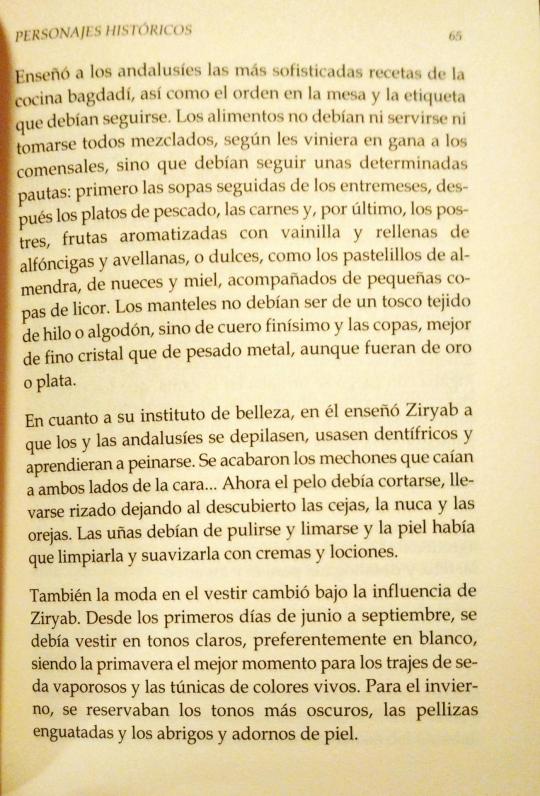
He taught the Andalusians the most sophisticated recipes of Baghdad cuisine, as well as the order at the table and the etiquette that had to be followed. The food should not even served or taken all mixed, as the diners wanted, but they had to follow certain guidelines: first the soups followed by the hors d'oeuvres, then the fish dishes, the meats and, finally, the desserts, fruits flavored with vanilla and stuffed with alphoncigas and hazelnuts, or sweets, such as almond, walnut and honey pastries, accompanied by small glasses of liquor. The tablecloths should not be of a coarse woven linen or cotton,nbut of very fine leather and the cups, better of fine crystal than of heavy metal, even if they were gold or silver.
As for his beauty institute, Ziryab taught the Andalusian to shave their hair, use toothpaste and to comb their hair. The strands that fell on both sides of the face ended... Now the hair had to be cut, worn curly, revealing the eyebrows, the nape of the neck and the ears. Nails should be polished and filed and the skin had to be cleaned and softened with creams and lotions.
Fashion in clothing also changed under the influence of Ziryab. Since the first days from June to September, they had to dress in light colors, preferably in white, spring being the best time for suits of gauzy silk and brightly colored tunics. For winter, they reserved the darker tones, the quilted pelisses and the fur coats and decorations.
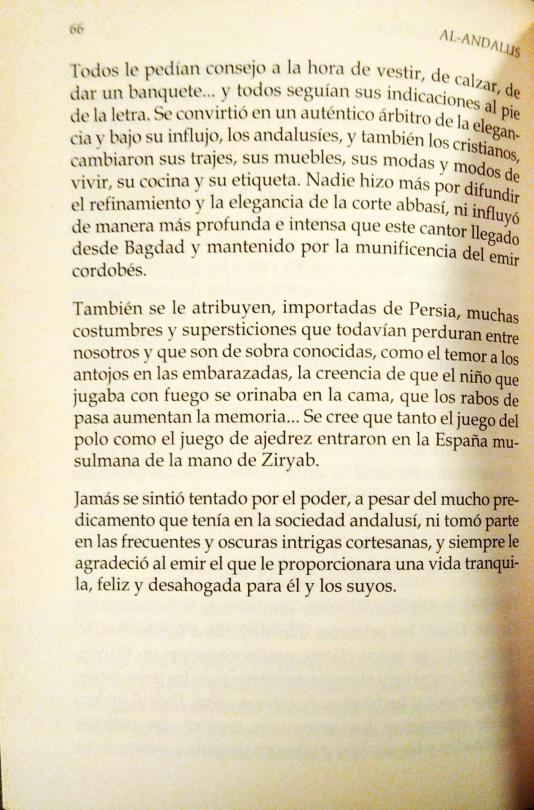
Everyone asked him for advice when it came to dressing, fitting shoes, giving a banquet... and everyone followed his instructions fully. It became a real
arbiter of elegance and under his influence, the Andalusians, and also the
Christians, changed their clothes, their furniture, their fashions and ways of living, their kitchen and their etiquette. No one did more to spread refinement and elegance of the Abbasid court, nor did he influence in a more profound and intense way than this singer arrived from Baghdad and maintained by the munificence of the Emir of Córdoba.
Also attributed to him, imported from Persia, are many customs and
superstitions that still exist among us and that are too known, such as the fear of cravings in pregnant women, the belief thatbthe boy who played with fire wet the bed, the tails of raisin increase memory... It is believed that both the game of polo and the game of chess entered Muslim Spain at the hands of Ziryab.
He never felt tempted by power, despite the much premedication that he had in Andalusian society, nor did he take part in the frequent and dark courtesans intrigues, and he always thanked the emir for providing him with a better, calm, happy and comfortable life for him and his people.

Tarub: the favorite of Abd al-Rahman II
All historians recognize that this emir was a complete womanizer. The young virgins, arriving from all corners, populated the harem of this man, so different from his father, the strict al-Hakam, who had bequeathed him a kingdom almost pacified, with the Treasury coffers filled to overflowing, which allowed him dedicate to all the pleasures that life can offer. Of his many concubines, wives and favorites, there was one whom it seems he loved more than all the others, Tarub, whose success with the caliph was perhaps due to her being surly, selfish and desired.
She must have been very beautiful, at least in the eyes of the enamored emir who, a man of great education and good poet, said of her: "Whenever I see the sun rise that illuminates reminds me of Tarub, a girl adorned with the trappings of beauty:
"The eye that contemplates it believes it sees a beautiful gazelle in it".
When he was not on an expedition, Abd al-Rahman II, like all sovereigns and
nobles of the era, went hunting, to the mountains of Sierra Morena or to the marshes of the Guadal-
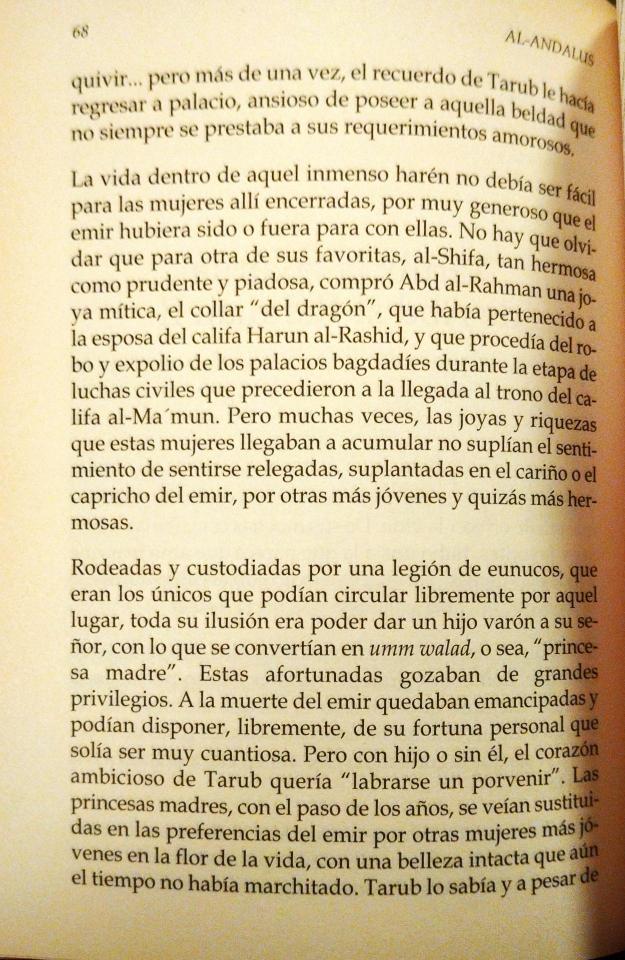
quivir... but more than once, the memory of Tarub made him return to the palace,
eager to possess that beauty who did not always respond to his amorous requirements.
Life inside that immense harem it couldn't have been easy for the women locked up there no matter how generous the emir had been or was towards them. There is no need to forget that for another of his favorites, al-Shifa, as beautiful as prudent and pious, Abd al-Rahman bought a mythical jewel, the dragon necklace, which had belonged to the wife of the caliph Harun al-Rashid, and that it came from the robbery and looting of the badgadi palaces during the period of the civil struggles that preceded the accession to the throne of the caliph al-Ma'mun. But many times, the jewels and riches that these women
accumulated did not make up for the feeling of feeling relegated, supplanted in the affection or whim of the emir, by others younger and perhaps more beautiful.
Surrounded and guarded by a legion of eunuchs, who were the only ones who could move freely through that place, their whole dream was to be able to give
a male child to their lord, with which they became umm walad, that is, "princess mother." These lucky ones enjoyed great privileges. To the death of the emir were emancipated and could freely dispose of
her personal fortune that used to be very large. But with or without a child, the
ambitious heart of Tarub wanted to “make a future for herself.” The princesses
mothers, as the years went by, saw themselves replaced in the prime of life,
with an intact beauty that time had not yet withered. Tarub knew it and despite
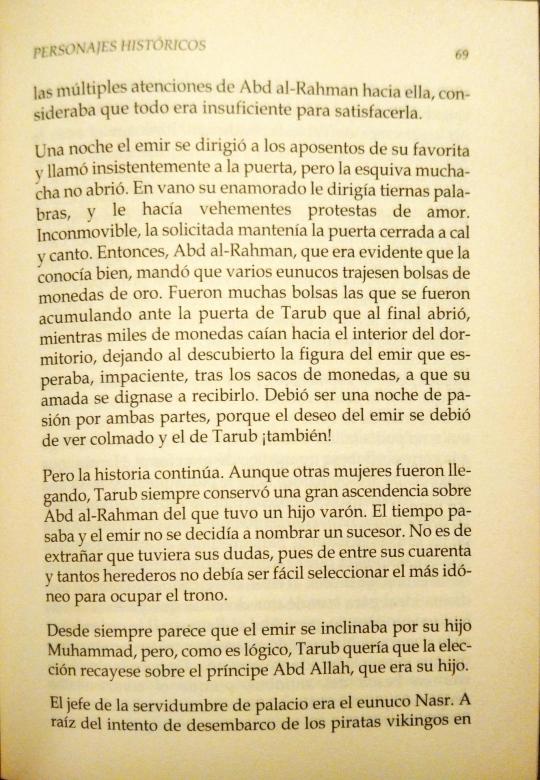
Abd al-Rahman's multiple attentions towards her, she considered that everything was insufficient to satisfy it.
One night the emir went to his favorite's chambers and called insistently at the door, but the elusive girl did not open it. In vain her lover spoke tender words to her, and made vehement protests of love. Unmovable, the requested one kept the door firmly closed. Then Abd al-Rahman, who clearly knew her well, ordered that several eunuchs carried bags of gold coins. There were many bags that were accumulating before the gate of Tarub that he finally opened, while thousands of coins fell into the bedroom, exposing the figure of the emir who waited, impatiently, behind the bags of coins, for his beloved would deign to receive him. It must have been a night of passion for both of us.
parts, because the emir's wish must have been fulfilled and Tarub's too!
But the story continues. Although other women arrived, Tarub always retained a great ancestry over Abd al-Rahman from whom he had a son. Time passed and the emir could not decide to name a successor. It is not surprising that he had his doubts, since among his forty heirs it couldn't be easy to select the most suitable one to occupy the throne.
It always seems that the emir was inclined towards his son Muhammad, but, of course, Tarub wanted the choice to fall to Prince Abd Allah, who was her son.
The head of the palace servants was the eunuch Nasr. Following the attempt to
landing of the viking pirates in

al-Andalus, Nasr had distinguished himself by his heroic behavior and by having defeated them in the battle that took place near Tablada. All this did that the emir appreciated him in a special way and that his influence at court was increasingly greater. Nasr and Tarub got along very well, they were both ambitious, and the princess mother, desperate to see her son named
successor decided, with the support of the eunuch, to plot a plot, quite sinister indeed, to ensure the much-desired succession to his son Abd Allah. The plot involved poisoning the prince who was presumed to be possible heir, Muhammad,... and by the way, and just in case the fact aroused suspicion, also ending the father, that is, the emir.
It was a very risky plan for Tarub but she was sure that with the complicity of Nasr, one of the strongest men at court and,
possibly the closest to the emir, she could not fail. And it happened that, in
those days, a very famous doctor, Harrán, arrived at the Cordoban court, who
came from Mesopotamia. Nasr asked him to prepare a drink poisoned and the doctor did not dare to deny him. Afterwards, he felt remorse and confessed the plot to another of the princess mothers, Farj, who
informed the emir of the conspiracy that was being hatched against him. The eunuch presented the deadly concoction to the emir, offering it to him as the ideal medicine to cure an ailment that he had been suffering from for some time, but Abd al-Rahman II ordered him to take it himself. Nasr was trapped and had no more remedy than drinking the poisoned drink. It was of little use to him to run in searchbof the antidote, because the counterpoison prepared by the doctor al-Harraní, wasn't effective and the eunuch died.
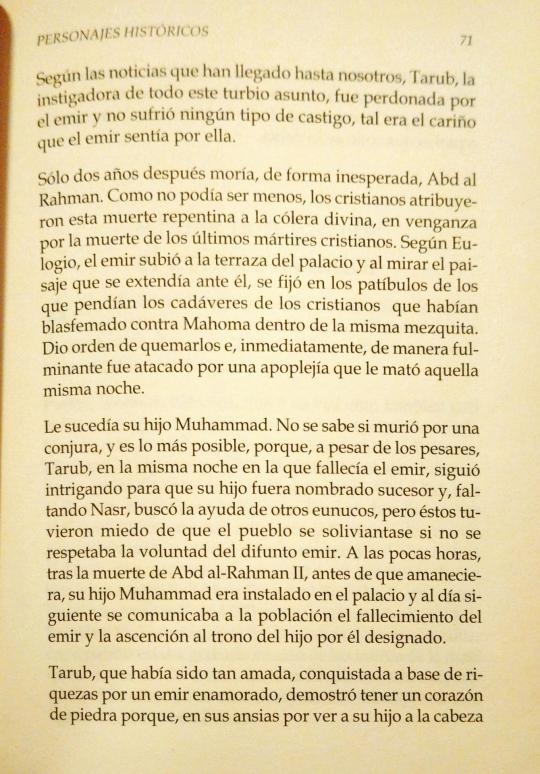
According to the news that has reached us, Tarub, the instigator of all this murky affair, was forgiven by the emir and did not suffer any type of punishment, such was
the affection that the emir felt for her.
Only two years later, Abd al Rahman died, unexpectedly. The Christians attributed this sudden death to divine anger, in
revenge for the death of the last Christian martyrs. According to Eulogio, the emir went up to the terrace of the palace and, looking at the landscape that stretched before him, noticed the scaffolds from which hung the corpses of the Christians who had blasphemed against Muhammad within the same mosque. He gave the order to burn them and, immediately, in a sudden manner, he was attacked by an apoplexy that killed that same night.
He was succeeded by his son Muhammad. It is not known if he died as a result of a conspiracy, and it is the most
possible, because, despite the regrets, Tarub, on the same night in which the
emir, continued to intrigue so that his son would be named successor and, with Nasr missing, she sought the help of other eunuchs, but they were afraid that the people would became angry if the will of the late emir was not respected. A few hours after the death of Abd al-Rahman II, before dawn, his son Muhammad wasinstalled in the palace and the next day the population was informed of the
death of the emir and the ascension to the throne of the son designated by him.
Tarub, who had been so loved, conquered with wealth by an emir in love, proved to have a heart of stone because, in her eagerness to see his son in the lead
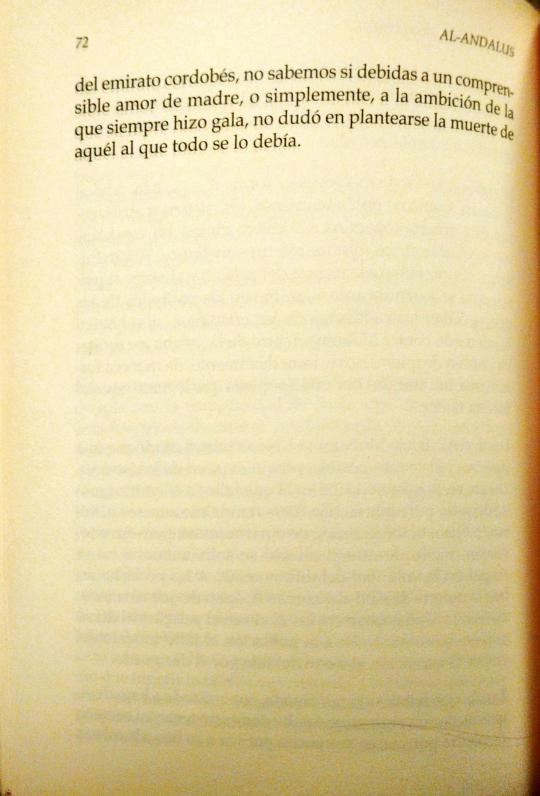
of the emirate of Cordoba, we do not know if due to an understandable love as a mother, or simply, to the ambition that she always displayed, she did not hesitate to consider the death of the one to whom she owed everything.

Abbas ben Firnas: the first aviator
Abd al-Rahman II was, without a doubt, the most cultured of all the emirs and
Hispano-Umayyad caliphs. Only one of his descendants, al-Hakam II, could compare him in terms of intellectual curiosity.
Poets, writers, philosophers, who in turn were also almost all astrologers, to whom
which the Muslims attached so much importance, were part of the court
by Abd al-Rahman. We will mention some of them, of great talent, who excelled in different areas of knowledge, such as Abd Allah ben al-Shamir, magnificent versifier; Ibrahim ben Sulayman al-Shamí, whose religious and mystical poems achieved great relevance throughout the Muslim world; Uthman ben al-Muthanna, grammarian, who became a preceptor to the royal princes; Said ben Farach al-Rashshash, who knew more than 4,000 mnemonics poems by heart and his brother Muhammad, who established the measurement of the Andalusian cubit, whose pattern was engraved on one of the walls of the main mosque from Córdoba... The list of wise men would be very long. But among all of them the figure of Abbas ben Firnas is especially important.
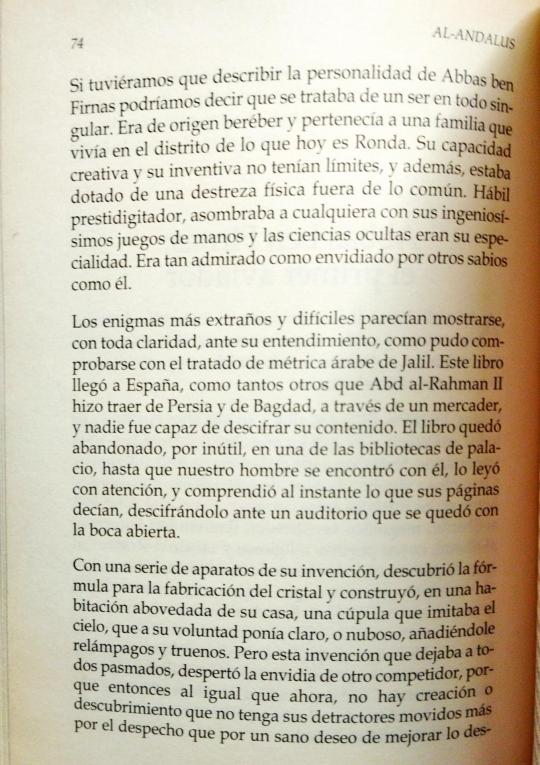
If we had to describe the personality of Abbas ben Firnas we could say that it was a being in every way singular. He was of Berber origin and belonged to a family that lived in the district of what is now Ronda. His creative ability and his inventiveness had no limits, and in addition, he was endowed with physical dexterity out of the ordinary. Skilled conjurer, he amazed anyone with his ingenious sleight of hand and occult sciences were his specialty. Was
as admired as envied by other wise men like him.
The strangest and most difficult enigmas seemed to show themselves, with complete clarity, before their understanding, as could be verified with the treatise on Arabic metrics of Jalil. This book arrived in Spain, like so many others that Abd al-Rahman II had brought
from Persia and Baghdad, through a merchant, and no one was able to decipher his content. The book was abandoned, as useless, in one of the libraries of palace, until our man came across it, read it carefully, and instantly understood what its pages said, deciphering it before a
audience that was left with their mouths open.
With a series of devices of his invention, he discovered the formula for the manufacturing glass and built, in a vaulted room in his house, a dome that imitated the sky, which at will made it clear or cloudy, adding lightning and thunder. But this invention that left everyone stunned, aroused the envy of another competitor, because then just as that now, there is no creation or discovery that does not have its detractors, motivated more by spite than by a healthy desire to improve what was
#al andalus historical figures#al andalus personajes históricos#book scans#bookblr#historyblr#al andalus#al andalus history#ziryab#zyriab the singer of baghdad#abu l-hasan ali ibn nafi`#abd al rahman ii#abd al rahman ii of córdoba#tarub#abbás ibn firnás#emirate of cordoba#spanish history#tw death#tw mysoginy#(for tarub's chapter)
13 notes
·
View notes






